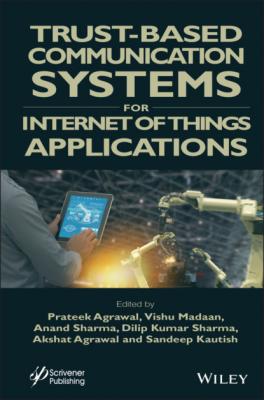Trust-Based Communication Systems for Internet of Things Applications. Группа авторов
Чтение книги онлайн.
Читать онлайн книгу Trust-Based Communication Systems for Internet of Things Applications - Группа авторов страница 15
 any block in the blockchain network needs to reach a consensus. Depending on the scale of the network and the number of blocks or nodes participating in a blockchain, the back and forth interactions participating in achieving agreement will take substantial time and resources.
any block in the blockchain network needs to reach a consensus. Depending on the scale of the network and the number of blocks or nodes participating in a blockchain, the back and forth interactions participating in achieving agreement will take substantial time and resources.
2.4 Conclusion
The purpose of this chapter was to get an authentication framework for IoT that is generic, flexible, and simple to maintain and introduce a PoC model that demonstrates our design. Accordingly, our approach grows well as several restricted channels are linked to the blockchain system simultaneous with unique nodes called control nodes. Additionally, we are able to provide such a tremendous amount of mobility with the various features of different ownership hub ecosystems across the entire blockchain network and link it to our restricted networks. Our approach will generally adjust to different IoT situations, indicating that IoT is completely incorporated into cryptocurrency. The IoT security industry and academics are gaining considerable attention from the media. Due to higher energy demand and downtime production, current protection technologies are not inherently appropriate for IoT. We initially proposed to use Bitcoin BC, which is a constant frame repository, in order to overcome these problems. We outlined the different core elements of the intelligent home level and addressed the different operations and processes involved.
References
1. Dorri, A., Kanhere, S.S., Jurdak, R. and Gauravaram, P., 2017, March. Blockchain for IoT security and privacy: The case study of a smart home. In 2017 IEEE international conference on pervasive computing and communications workshops (PerCom workshops) (pp. 618-623). IEEE.
2. Novo, O., 2018. Blockchain meets IoT: An architecture for scalable access management in IoT. IEEE Internet of Things Journal, 5(2), pp.1184-1195.
3. Biswas, K. and Muthukkumarasamy, V., 2016, December. Securing smart cities using blockchain technology. In 2016 IEEE 18th international conference on high performance computing and communications; IEEE 14th international conference on smart city; IEEE 2nd international conference on data science and systems (HPCC/SmartCity/DSS) (pp. 1392-1393). IEEE.
4. Nir Kshetri, “Can Blockchain Strengthen the Internet of Things?,” IT Professional, vol. 19, no. 4, pp. 68-72, May 2017, Available: http://ieeexplore.ieee.org/document/8012302/
5. Mahdi H. Miraz, Maaruf Ali, Peter Excell, and Picking Rich, “A Review on Internet of Things (IoT), Internet of Everything (IoE) and Internet of Nano Things (IoNT),” in the Proceedings of the Fifth International IEEE Conference on Internet Technologies and Applications (ITA 15), Wrexham, UK, 2015, pp. 219–224.
6. Mahdi H. Miraz and Maaruf Ali, “Blockchain Enabled Enhanced IoT Ecosystem Security,” (accepted) in proceedings of the First International Conference on Emerging Technologies in Computing 2018 (iCETiC ‘18), London, UK, 23 August 2018.
7. Maaruf Ali and Mahdi H. Miraz, “Recent Advances in Cloud Computing Applications and Services,” International Journal on Cloud Computing (IJCC), vol. 1, no. 1, pp. 1-12, February 2014.
8. Xueping Liang et al., “ProvChain: A Blockchain-based Data Provenance Architecture in Cloud Environment with Enhanced Privacy and Availability,” in Proceedings of the 17th IEEE/ACM International Symposium on Cluster, Cloud and Grid Computing (CCGrid ‘17), Madrid, Spain, May 14 - 17, 2017, pp. 468-477.
9. Sarah Underwood, “Blockchain Beyond Bitcoin,” Communications of the ACM, vol. 59, no. 11, pp. 15-17, November 2016, Available: https://doi.org/10.1145/2994581
10. D. Makrushin and V. Dashchenko, Fooling the ’Smart City’, Technical Report, Kaspersky Lab, pp. 1–22, Sep. 2016.
11. K. Christidis and M. Devetsikiotis, Blockchains and Smart Contracts for the IoTs, IEEE Access, Special section on the plethora of Research in IoT, pp. 2292–2303, 2016.
12. Christidis, Konstantinos, and Michael Devetsikiotis. “Blockchains and Smart Contracts for the Internet of Things.”
13. QiJing, Athanasios VVasilakos, JiafuWan, JingweiLu, and DechaoQiu.2014. Security of the internet of things: Perspectives and challenges. Wireless Networks 20, 8(2014), 2481–2501.
14. Ali Dorri, Salil S Kanhere, Raja Jurdak, and Praveen Gauravaram. 2017. Blockchain for IoT Security and Privacy: The Case Study of a Smart Home. In IEEE Percom workshop on security privacy and trust in the internet of thing. IEEE
15. Giacomo Brambilla, Michele Amoretti, and Francesco Zanichelli.2016. Using Blockchain for Peer-to-Peer Proof of Location. arXiv preprint arXiv:1607.00174 (2016).
16. Yves-Alexandre de Montjoye, Erez Shmueli, Samuel S Wang, and Alex Sandy Pentland.2014.openpds: Protecting the privacy of meta data through safe answers. PloS one 9,7(2014),e98790
17. Nakamoto, S., 2012. Bitcoin: A peer-to-peer electronic cash system, Oct,2008.
18. Wikipedia, “Blockchain”, https://en.wikipedia.org/wiki/Blockchain#cite_notete20151031-1.
19. CNNMoney “What is Bitcoin” http://money.cnn.com/infographic/technology/what-is-Bitcoin/
20. Wikipedia, “Bitcoin”, https://en.wikipedia.org/wiki/Bitcoin.
21. Vitalik Buterin, “Ethereum and The Decentralized Future”. Future Thinkers Podcast. 2015-04-21. Retrieved 2016-05-13.
22. Hyperledger, “About Hyperledger”, HTTPs://www.hyperledger.org/about.
23. Christian C., Elli A., Angelo De Caro, Andreas K., Mike O., Simon S., Alessandro S., Marko V,. et al, “Blockchain, cryptography, and consensus”, IBM Research Zurich, June 2017.
24. Ripple, “RippleNet”, https://ripple.com
25. Neelakandan, S & Paulraj, D 2020, ‘A gradient boosted decision tree-based sentiment classification of twitter data’, International Journal of Wavelets, Multiresolution and Information Processing, vol.18, no. 4, pp. 205027 1-21. DOI: https://doi.org/10.1142/S0219691320500277.
26. Neelakandan, S & Paulraj, D 2020, ‘An Automated Exploring And Learning Model For Data Prediction Using Balanced CA-Svm’, Journal of Ambient Intelligence and Humanized Computing, Vol.12, no.5, April 2020, DOI: https://doi.org/10.1007/s12652-020-01937-9.
27. Neelakandan, S, Annamalai, R., Rayen, S. J., & Arunajsmine, J. (2020). Social Media Networks Owing To Disruptions For Effective Learning. Procedia Computer Science, Vol. 172, pp. 145–151. doi:10.1016/j.procs.2020.05.022.
28. S. Neelakandan and J. Gokul Anand, “Trust based optimal routing in MANET’s,” 2011 International Conference on Emerging Trends in Electrical and Computer Technology, Nagercoil, India, 2011, pp. 1150-1156, doi: 10.1109/ICETECT.2011.5760293.